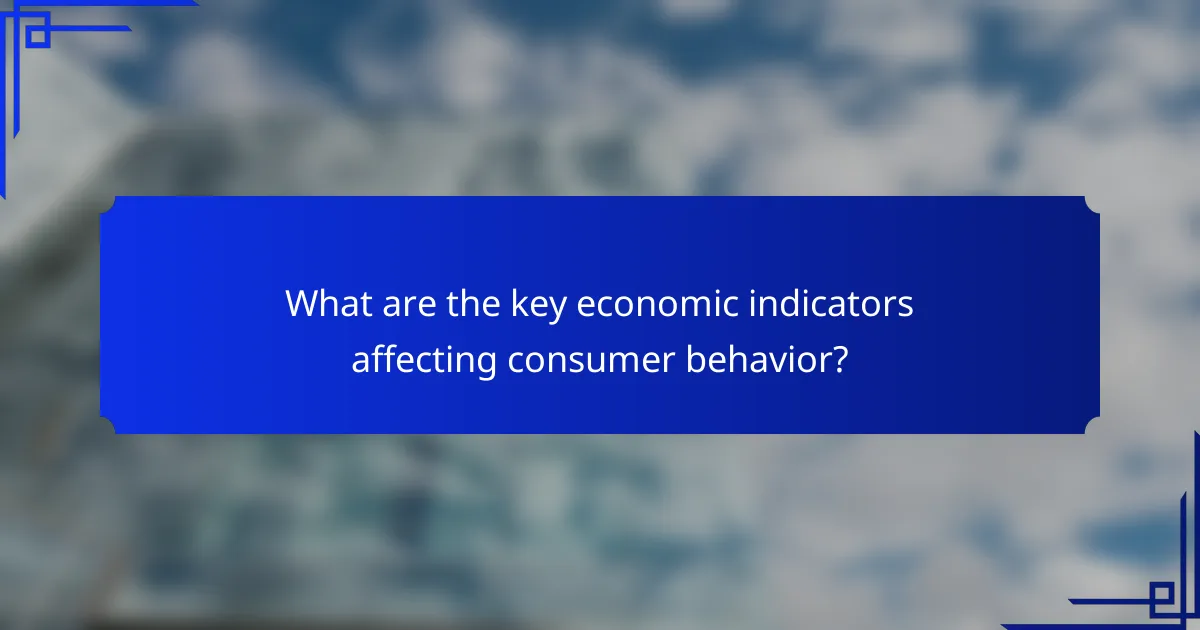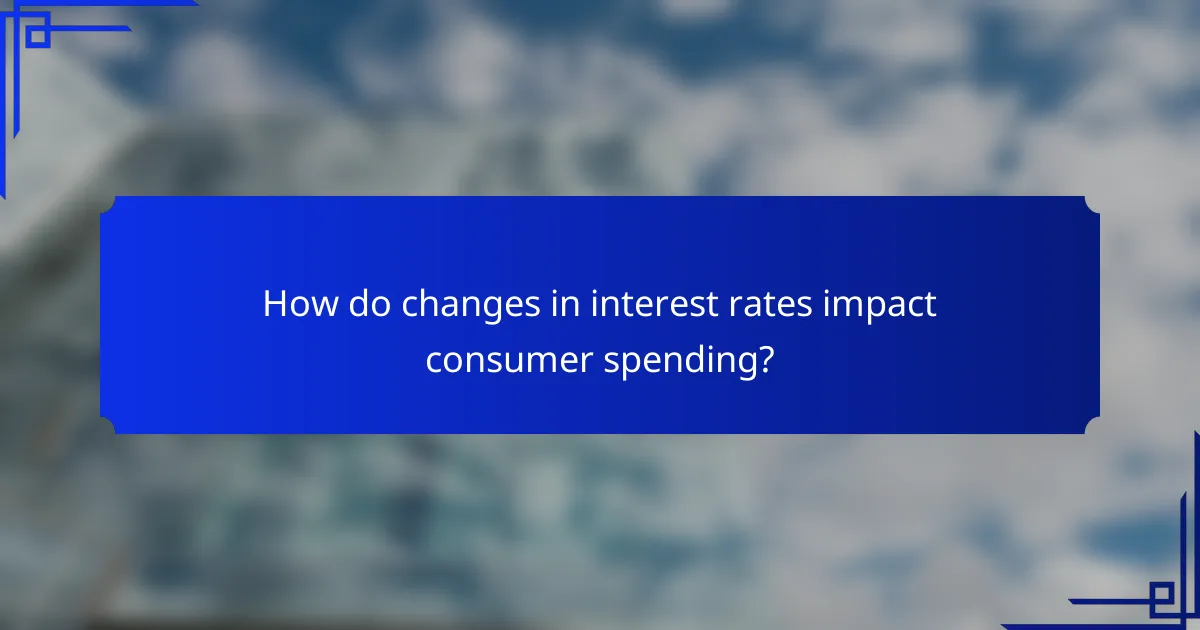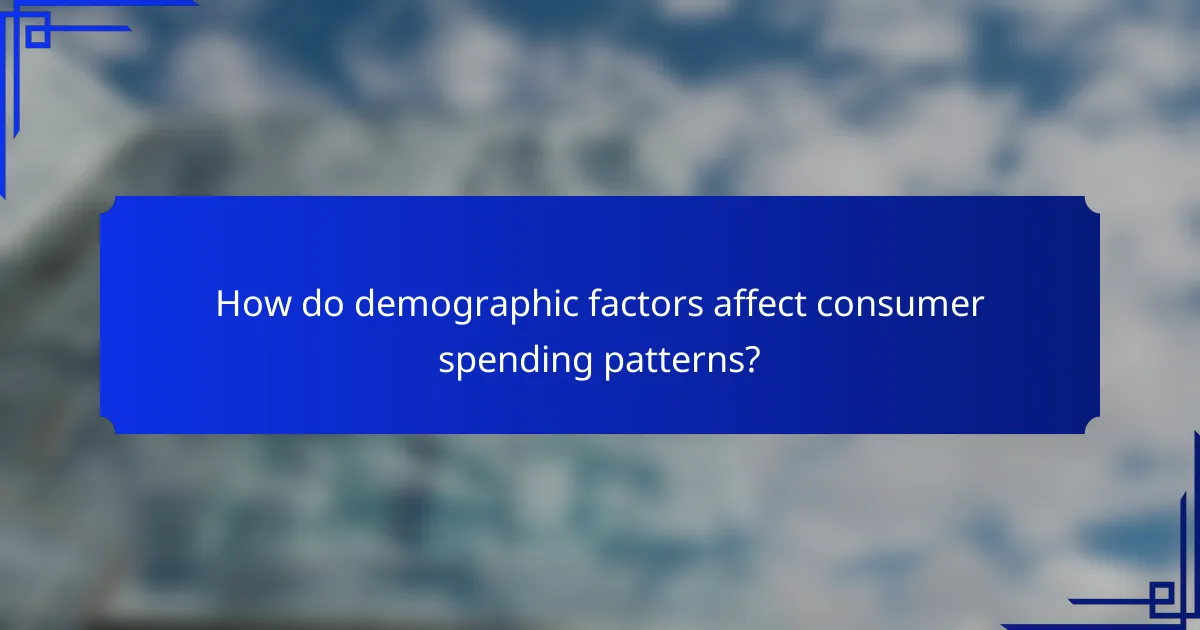Economic factors play a pivotal role in shaping consumer spending and behavior, as they directly influence disposable income, purchasing power, and financial confidence. Key indicators such as Gross Domestic Product (GDP) and inflation rates provide insights into economic stability, guiding consumers in their spending decisions. Additionally, fluctuations in interest rates can significantly alter borrowing costs, further impacting how consumers allocate their budgets and invest in goods and services.

How do economic factors influence consumer spending in the United States?
Economic factors significantly impact consumer spending in the United States by affecting disposable income, purchasing power, and overall financial confidence. Changes in income levels, inflation rates, employment rates, consumer confidence, and interest rates all play crucial roles in shaping how consumers allocate their budgets.
Income levels
Income levels directly affect consumer spending, as higher incomes typically lead to increased purchasing power. When individuals earn more, they are likely to spend more on both essential and discretionary items, boosting overall economic activity.
Conversely, stagnant or declining income levels can force consumers to cut back on spending, prioritizing necessities over luxuries. For example, during economic downturns, households may reduce expenditures on dining out, entertainment, and non-essential goods.
Inflation rates
Inflation rates influence consumer spending by eroding purchasing power. When prices rise, consumers may find that their money does not stretch as far, leading to reduced spending on goods and services.
For instance, if inflation is high, consumers might limit their purchases to essential items, avoiding luxury goods or services. This shift can slow economic growth, as businesses may see decreased sales and adjust their operations accordingly.
Employment rates
Employment rates have a strong correlation with consumer spending. Higher employment typically results in increased consumer confidence and spending, as more individuals have stable incomes.
In contrast, high unemployment can lead to decreased consumer spending, as job loss creates uncertainty and financial strain. For example, during periods of high unemployment, families may prioritize savings over spending, impacting businesses and the economy as a whole.
Consumer confidence
Consumer confidence reflects how optimistic consumers feel about the economy and their financial situation, which directly influences spending behavior. When confidence is high, consumers are more likely to make significant purchases, such as homes or cars.
On the other hand, low consumer confidence can lead to cautious spending habits. For instance, during economic uncertainty, consumers may choose to save rather than spend, which can contribute to slower economic growth.
Interest rates
Interest rates affect consumer spending by influencing borrowing costs. Lower interest rates make loans cheaper, encouraging consumers to finance larger purchases, such as homes and vehicles.
Conversely, higher interest rates can deter borrowing and spending, as consumers may face increased costs for loans and credit. This can lead to a slowdown in economic activity, as businesses may experience reduced demand for their products and services.

What are the key economic indicators affecting consumer behavior?
Key economic indicators such as Gross Domestic Product (GDP), Consumer Price Index (CPI), and retail sales data significantly influence consumer behavior by shaping perceptions of economic stability and purchasing power. Understanding these indicators helps businesses and policymakers anticipate shifts in consumer spending patterns.
Gross Domestic Product (GDP)
Gross Domestic Product (GDP) measures the total economic output of a country and serves as a primary indicator of economic health. When GDP is growing, consumers generally feel more confident about their financial situation, leading to increased spending on goods and services.
Conversely, a declining GDP can signal economic troubles, prompting consumers to cut back on discretionary spending. For example, during periods of low GDP growth, households may prioritize essential expenses over luxury items, affecting various sectors differently.
Consumer Price Index (CPI)
The Consumer Price Index (CPI) tracks changes in the price level of a basket of consumer goods and services, reflecting inflation. A rising CPI indicates that prices are increasing, which can erode purchasing power and lead consumers to adjust their spending habits.
For instance, if the CPI rises significantly, consumers may choose to buy less expensive alternatives or delay non-essential purchases. Businesses must monitor CPI trends to adjust pricing strategies and inventory management accordingly.
Retail sales data
Retail sales data provides insights into consumer spending trends across various sectors, indicating how much consumers are purchasing over a specific period. Strong retail sales figures often correlate with increased consumer confidence, suggesting that people are willing to spend more.
On the other hand, weak retail sales can indicate economic uncertainty, prompting businesses to reassess their marketing strategies and inventory levels. Tracking these trends helps companies make informed decisions about product offerings and pricing to align with consumer demand.

How do changes in interest rates impact consumer spending?
Changes in interest rates significantly affect consumer spending by altering borrowing costs and influencing financial behavior. When interest rates rise, borrowing becomes more expensive, which can lead to reduced consumer spending and investment.
Borrowing costs
Higher interest rates increase borrowing costs for consumers, making loans more expensive. This can discourage individuals from taking out loans for big-ticket items like cars or appliances, leading to a decline in overall consumer spending. For example, a 1% increase in interest rates can raise monthly payments on a car loan by several dollars, which may deter potential buyers.
Consumers should consider the total cost of borrowing when interest rates rise. It may be wise to evaluate fixed-rate loans versus variable-rate options, as fixed rates can provide stability in uncertain economic conditions.
Mortgage rates
Mortgage rates are directly influenced by changes in interest rates, impacting home buying and refinancing decisions. When rates increase, potential homebuyers may delay purchasing a home or opt for less expensive properties, which can slow down the housing market. A rise in mortgage rates can add hundreds of dollars to monthly payments, affecting affordability.
Homeowners considering refinancing should act quickly when rates are low, as even a small increase can negate potential savings. It’s essential to calculate the break-even point to determine if refinancing is worthwhile.
Credit card interest
Changes in interest rates also affect credit card interest rates, which can impact consumer behavior. Higher rates mean that carrying a balance becomes more costly, leading consumers to pay off debts more quickly or avoid new purchases. This can result in decreased discretionary spending.
Consumers should monitor their credit card interest rates and consider transferring balances to cards with lower rates or paying off high-interest debt first. Keeping credit utilization low can also help maintain better credit scores, which may lead to more favorable borrowing terms in the future.

What role does consumer confidence play in spending habits?
Consumer confidence significantly influences spending habits, as it reflects how optimistic individuals feel about the economy and their financial situation. When confidence is high, consumers are more likely to spend on non-essential items, while low confidence typically leads to increased saving and reduced spending.
Impact on discretionary spending
Discretionary spending, which includes non-essential purchases like dining out, vacations, and luxury items, is heavily affected by consumer confidence. When people feel secure in their jobs and financial outlook, they are more inclined to indulge in these types of expenses. Conversely, during economic uncertainty, discretionary spending often declines, with consumers prioritizing essential goods and services.
For example, during periods of high consumer confidence, retail sectors such as travel and entertainment tend to see growth, while downturns can lead to significant drops in these areas. Businesses often adjust their marketing strategies based on consumer sentiment to capitalize on these trends.
Influence on savings rates
Consumer confidence also plays a critical role in determining savings rates. When confidence is low, individuals tend to save more as a precaution against potential economic downturns or job loss. This behavior can lead to higher savings rates, as consumers prioritize financial security over spending.
In contrast, when confidence is high, people may feel more comfortable spending rather than saving, leading to lower savings rates. For instance, during economic booms, savings rates can drop significantly as consumers invest in experiences and goods, while recessions often see a spike in savings as a protective measure.

How do demographic factors affect consumer spending patterns?
Demographic factors significantly influence consumer spending patterns by shaping preferences, purchasing power, and consumption habits. Key demographics such as age, income, and geographic location play crucial roles in determining how and where consumers allocate their money.
Age groups
Different age groups exhibit distinct spending behaviors due to varying needs and life stages. For instance, younger consumers, typically in their twenties, may prioritize technology and entertainment, while older adults often focus on healthcare and retirement savings.
As people age, their spending tends to shift from discretionary items to essential goods and services. Understanding these trends helps businesses tailor their marketing strategies to meet the specific needs of each age segment.
Income brackets
Income brackets are a primary determinant of consumer spending, as they directly affect purchasing power. Higher-income households generally have more disposable income, allowing them to spend on luxury items, travel, and experiences, while lower-income groups may focus on basic necessities.
Businesses can benefit from segmenting their target markets based on income levels to create appropriate pricing strategies and product offerings. For example, discount retailers cater to budget-conscious consumers, while premium brands target affluent shoppers.
Geographic regions
Geographic regions influence consumer spending due to cultural differences, economic conditions, and local market dynamics. Urban areas may see higher spending on dining and entertainment, while rural regions might prioritize agricultural products and home improvement.
Regional economic factors, such as cost of living and employment rates, also play a critical role. For example, consumers in high-cost cities like San Francisco may spend more on housing, which affects their discretionary spending in other categories.

What are the effects of inflation on consumer purchasing decisions?
Inflation significantly impacts consumer purchasing decisions by reducing the purchasing power of money, leading consumers to rethink their spending habits. As prices rise, individuals may prioritize essential goods and services over discretionary spending, altering their overall consumption patterns.
Changes in spending habits
As inflation increases, consumers often shift their spending habits by focusing on necessities rather than luxury items. For example, families may cut back on dining out and entertainment, opting instead for home-cooked meals and free activities. This shift can lead to decreased sales in non-essential sectors, affecting businesses reliant on discretionary spending.
Impact on savings and investments
Inflation can erode the value of savings, prompting consumers to seek higher returns on their investments. Many individuals may turn to assets like stocks or real estate, which historically outpace inflation, rather than keeping money in low-interest savings accounts. This behavior can lead to increased market volatility as more people invest in riskier assets to protect their purchasing power.
Consumer confidence and economic outlook
Rising inflation often diminishes consumer confidence, as individuals become uncertain about their financial futures. When consumers feel less secure, they tend to spend less, which can slow economic growth. Conversely, if inflation stabilizes, confidence may return, encouraging increased spending and investment.
